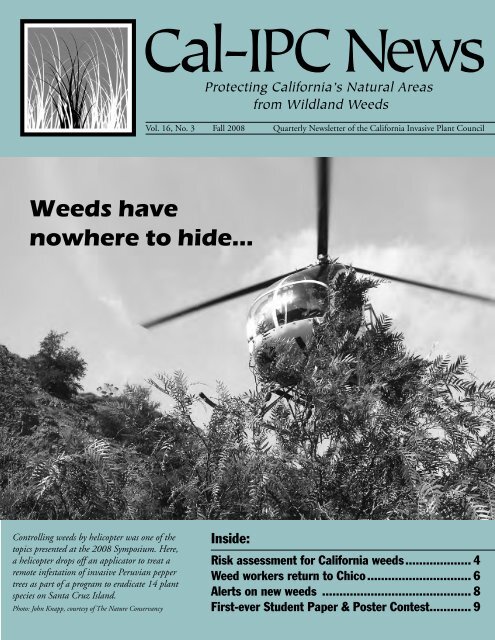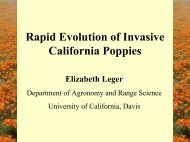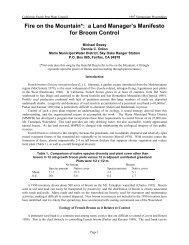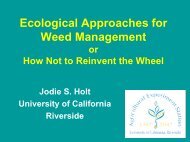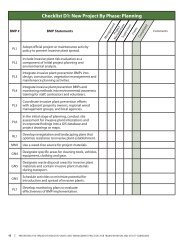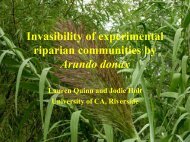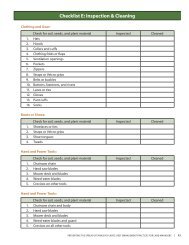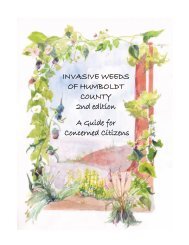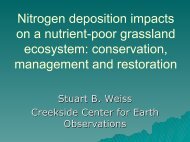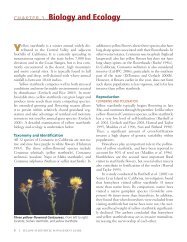Fall 2008 - Cal-IPC
Fall 2008 - Cal-IPC
Fall 2008 - Cal-IPC
You also want an ePaper? Increase the reach of your titles
YUMPU automatically turns print PDFs into web optimized ePapers that Google loves.
<strong>Cal</strong>-<strong>IPC</strong> News<br />
Protecting <strong>Cal</strong>ifornia’s Natural Areas<br />
from Wildland Weeds<br />
Vol. 16, No. 3 <strong>Fall</strong> <strong>2008</strong> Quarterly Newsletter of the <strong>Cal</strong>ifornia Invasive Plant Council<br />
Weeds have<br />
nowhere to hide...<br />
Controlling weeds by helicopter was one of the<br />
topics presented at the <strong>2008</strong> Symposium. Here,<br />
a helicopter drops off an applicator to treat a<br />
remote infestation of invasive Peruvian pepper<br />
trees as part of a program to eradicate 14 plant<br />
species on Santa Cruz Island.<br />
Photo: John Knapp, courtesy of The Nature Conservancy<br />
Inside:<br />
Risk assessment for <strong>Cal</strong>ifornia weeds................... 4<br />
Weed workers return to Chico............................... 6<br />
Alerts on new weeds ............................................ 8<br />
First-ever Student Paper & Poster Contest............ 9
<strong>Cal</strong>ifornia<br />
Invasive Plant<br />
Council<br />
1442-A Walnut Street, #462<br />
Berkeley, CA 94709<br />
(510) 843-3902<br />
fax (510) 217-3500<br />
www.cal-ipc.org<br />
info@cal-ipc.org<br />
A <strong>Cal</strong>ifornia 501(c)3 nonprofit organization<br />
Protecting <strong>Cal</strong>ifornia’s natural areas<br />
from wildland weeds through<br />
research, restoration, and education.<br />
STAFF<br />
Doug Johnson, Executive Director<br />
dwjohnson@cal-ipc.org<br />
Elizabeth Brusati, Project Manager<br />
edbrusati@cal-ipc.org<br />
Heather Brady, Project Coordinator<br />
hjbrady@cal-ipc.org<br />
Bertha McKinley, Office Manager<br />
bmckinley@cal-ipc.org<br />
DIRECTORS<br />
Jason Giessow, President (2009)<br />
Santa Margarita/San Luis Rey Weed Management Area<br />
Wendy West, Vice President (2009)<br />
U.C. Cooperative Extension<br />
Jennifer Erskine Ogden, Treasurer (2009)<br />
UC Davis<br />
John Knapp, Secretary (2009)<br />
Native Range, Inc.<br />
Dan Gluesenkamp, Past President (2009)<br />
Audubon Canyon Ranch<br />
Carolyn Cromer (2009)<br />
The Land Trust of Napa County<br />
Bob Case (<strong>2008</strong>)<br />
<strong>Cal</strong>ifornia Native Plant Society<br />
David Chang (<strong>2008</strong>)<br />
Santa Barbara Agricultural Commissioner’s Office<br />
Chris Christofferson (2009)<br />
Plumas National Forest<br />
Joanna Clines (<strong>2008</strong>)<br />
Sierra National Forest<br />
Jason Casanova (<strong>2008</strong>)<br />
Los Angeles/San Gabriel Rivers Watershed Council<br />
Doug Gibson (<strong>2008</strong>)<br />
San Elijo Lagoon Conservancy<br />
Beth Keer (2009)<br />
East Bay Regional Parks Botanic Garden<br />
Cheryl McCormick (<strong>2008</strong>)<br />
Santa Lucia Conservancy<br />
Tanya Meyer (2009)<br />
Yolo County Resource Conservation District<br />
Mark Newhouser (2009)<br />
Sonoma Ecology Center<br />
Kate Symonds (2009)<br />
US Fish & Wildlife Service<br />
Affiliations for identification purposes only.<br />
Last year of term noted.<br />
<strong>Cal</strong>-<strong>IPC</strong> News<br />
<strong>Fall</strong> <strong>2008</strong> - Volume 16, Number 3<br />
Editors: Doug Johnson, Elizabeth Brusati, Heather Brady<br />
<strong>Cal</strong>-<strong>IPC</strong> News is published quarterly by the <strong>Cal</strong>ifornia Invasive Plant Council.<br />
Articles may be reprinted with permission from the editor. Submissions are<br />
welcome. Mention of commercial products does not imply endoresement<br />
by <strong>Cal</strong>-<strong>IPC</strong>. We reserve the right to edit all work.<br />
From the Director’s Desk<br />
Strategic foresight<br />
Those working on the ground in natural resource management have their hands full<br />
with the day-to-day tasks of controlling invasive plants. It can be a victory to simply<br />
maintain several years of funding to complete the necessary follow-up on a project.<br />
Yet we know that prevention and early response activities for new weeds can be more<br />
cost-effective than managing full-blown infestations. It can be seen as a sign of progress that<br />
the natural resource community is beginning to focus more in these areas.<br />
At <strong>Cal</strong>-<strong>IPC</strong>, we are working to do our part. We have completed a two-year pilot<br />
project to map the potential for spread of wildland weeds already in the state, and to list<br />
international weeds that could become future problems here in <strong>Cal</strong>ifornia. Our efforts to<br />
map potential spread drew heavily on distribution data contributed by natural resources<br />
managers through local Weed Management Areas. To predict the potential for spread for<br />
each plant, we used climate matching software to determine additional suitable areas of the<br />
state not yet invaded. These maps show resource managers which weeds are most likely to<br />
move into their area. Likewise, the international list helps managers be on the lookout for<br />
infestations of new weeds, and provides a basis for screening plants that are proposed as new<br />
horticultural imports.<br />
<strong>Cal</strong>-HIP, the multi-stakeholder partnership behind PlantRight (www.plantright.org),<br />
is developing a risk assessment process to help further evaluate potential new horticultural<br />
introductions. Such screening also needs to be in place before committing to biofuel crops,<br />
many of which have invasive tendencies by virtue of the low-maintenance, fast-growing<br />
qualities desired in such plants.<br />
This approach of evaluating pests before they become a problem here is gaining steam<br />
through official channels as well. The Governor recently signed into law AB 2763, requiring<br />
state agencies to assess which invasive species—plants, animals, and plant and animal<br />
diseases—not yet introduced into <strong>Cal</strong>ifornia are a major threat. The bill was authored by<br />
Santa Cruz Assembly Member John Laird in the wake of his constituents’ concern about<br />
aerial spraying proposed to control light brown apple moth. The bill’s intent is for agencies<br />
and the public to vet proposed control measures (such as aerial spraying) ahead of time,<br />
rather than during a crisis requiring rapid action. The bill includes all invasive species that<br />
threaten the state’s economy or enviroment, and it is vital that we use this opportunity to<br />
prepare for future wildland pests, not just those that threaten agriculture.<br />
At the same time, local groups are organizing to stop the spread of key invasive plants.<br />
The Bay Area Early Detection Network received start-up funding from the National<br />
Fish & Wildlife Foundation, and will seek to be a model for reporting and tracking weed<br />
populations on a regional basis. <strong>Cal</strong>-<strong>IPC</strong> will support this project and others around the<br />
state by adding regional detail to our statewide Inventory of invasive plants. It is critical that<br />
the Inventory serve local resource managers, and that all plants suspected of being worthy of<br />
the “invasive” label be carefully assessed using our science-based criteria system.<br />
All of these efforts reflect a maturation of our field. By beginning to implement<br />
strategies focused on prevention and early detection activities will help us work smarter<br />
in the future. There is no mystery to what needs to be done—we need to support and<br />
expand upon successful programs like those run for a century by our county agricultural<br />
commissioners, and to build on new technologies, research, and stakeholders dedicated<br />
to this work. With the wild card of climate change shuffled into the deck, our work gets<br />
even more challenging. Here at <strong>Cal</strong>-<strong>IPC</strong>, we will continue to work with diverse partners on<br />
strategic initiatives designed to protect <strong>Cal</strong>ifornia’s wildlands into the future.<br />
<strong>Cal</strong>-<strong>IPC</strong> News <strong>Fall</strong> <strong>2008</strong>
Wildland Weed NewsNewsNewsNewsNews<br />
<strong>Cal</strong>ifornia Department of Fish and Game<br />
scientist Susan Ellis and UC Davis professor<br />
Joseph DiTomaso have been appointed to<br />
the advisory committee of the National<br />
Invasive Species Council (NISC). NISC<br />
is co-chaired by the Secretaries of the<br />
Interior, Agriculture and Commerce. The<br />
advisory committee represents a broad<br />
range of stakeholders including scientific,<br />
conservation, agriculture, state and tribal<br />
governments, and industry organizations<br />
impacted by invasive species. www.<br />
invasivespeciesinfo.gov/council/advisory.shtml<br />
AB 2763 was signed into law by Gov.<br />
Schwarzenegger, mandating that the state<br />
work on “advance planning” for invasive<br />
animals, plants, and animal and plant<br />
diseases. The bill puts the <strong>Cal</strong>. Dept. of<br />
Food & Agriculture as the lead agency, and<br />
instructs them to work with other agencies<br />
and stakeholders. The state is unable to fund<br />
the work, but plans to seek federal funds<br />
through the Farm Bill.<br />
A brown alga, Ascophyllum nodosum<br />
(pictured below), is spreading in San<br />
Francisco Bay. While marine biologists<br />
are not sure how serious this invader is,<br />
this is the first time it has been seen in the<br />
bay. It may be spread in packages of bait<br />
shipped from the East Coast. The National<br />
Oceanic and Atmospheric Administration,<br />
US Fish and Wildlife Service, and numerous<br />
volunteers are working to remove the algae.<br />
www.noaaworld.noaa.gov/conservation/<br />
aug<strong>2008</strong>_conservation_4.html<br />
A Los Angeles Times article entitled “Beige<br />
Plague” described how the conversion<br />
of sagebrush habitat to annual grasses,<br />
especially cheatgrass, has increased the<br />
intensity and frequency of wildfires in<br />
western states. Areas of the high desert that<br />
historically burned once a century now burn<br />
every few years. In 2005, 1 million acres of<br />
the Mojave Desert burned. In Elko, Nevada,<br />
courtship grounds for sage grouse, winter<br />
habitat for mule deer and food sources for<br />
pronghorn have all been burned away.<br />
Los Angeles Times, August 2, <strong>2008</strong><br />
The Oklahoma Invasive Plant Council<br />
formed this July, bringing the total number<br />
of states represented by Invasive Plant or<br />
Exotic Pest Plant Councils to 35.<br />
www.naeppc.org<br />
Invasive species are more abundant in<br />
manmade impoundments than in natural<br />
lakes and those impoundments act as<br />
stepping stones for invaders. So concluded<br />
researchers who examined five invasive<br />
species in the Great Lakes region, taking<br />
into account water chemistry, recreational<br />
use, and geographic distribution of the<br />
lakes. (Johnson et al., Frontiers in Ecology<br />
and Environment, September <strong>2008</strong>)<br />
<strong>Cal</strong>-<strong>IPC</strong> Updates<br />
Student Chapter<br />
The <strong>Cal</strong>-<strong>IPC</strong> Student Chapter formed<br />
at UC Riverside in 2007 to facilitate<br />
communication between students<br />
and professionals in invasive plant<br />
management. The chapter is recruiting<br />
new members and new schools. To find<br />
out more and receive a CD of start-up<br />
materials, contact calipcsc@gmail.com.<br />
Online Photo Gallery<br />
See <strong>Cal</strong>-<strong>IPC</strong> photos on Flickr! Former<br />
<strong>Cal</strong>-<strong>IPC</strong> staff and board member<br />
Brianna Richardson organized<br />
Symposium pictures, photo contest<br />
entries, plant photos, and many more<br />
into an online database. This is the<br />
first step in making our photos more<br />
accessible and showing the public the<br />
many facets of weed work. Contact us<br />
if you would like to use a photo for<br />
your outreach materials. www.flickr.<br />
com/photos/cal-ipc<br />
Early Detection Online<br />
A new section of our website provides<br />
resources for early detection, including<br />
maps and county watch lists.<br />
www.cal-ipc.org/ip/mapping/early_<br />
detection<br />
“Don’t Plant a Pest!” Reprinted<br />
We have reprinted the Central Valley<br />
and Sierra Foothills versions of the<br />
“Don’t Plant a Pest!” brochure. Request<br />
up to 50 free copies by emailing info@<br />
cal-ipc.org or calling 510-843-3902.<br />
Larger quantities may be ordered<br />
through our online store.<br />
Board of Directors Election Results<br />
Jason Casanova, Doug Gibson, Cheryl<br />
McCormick, and all officers were<br />
re-elected. New directors beginning<br />
terms in January are Edith Allen (UC<br />
Riverside), Henry Gonzales (Ventura<br />
County Agricultural Commissioner),<br />
Julie Horenstein (CA Dept. of Fish<br />
& Game), and Marc Lea (San Luis<br />
Obispo County Dept. of Agriculture).<br />
Ascophyllum nodosum, a new alga in San Francisco Bay. Photo: NOAA.<br />
<strong>Cal</strong>-<strong>IPC</strong> News <strong>Fall</strong> <strong>2008</strong>
Feature<br />
Predicting where weeds will spread<br />
Elizabeth Brusati, <strong>Cal</strong>-<strong>IPC</strong> Project Manager, edbrusati@cal-ipc.org<br />
Those who work to control invasive<br />
plants and restore habitats must balance<br />
their plans between the present and<br />
the future. Most of the work that happens<br />
in both research and management addresses<br />
the present, or at least the next couple<br />
of field seasons. For the past two years,<br />
<strong>Cal</strong>-<strong>IPC</strong> worked on a project to improve<br />
information on where invasive plants currently<br />
occur in <strong>Cal</strong>ifornia while assessing<br />
the risk of them spreading in the future.<br />
What weeds do your neighbors have? What<br />
new weeds are most likely to thrive in your<br />
county? What will happen as global climate<br />
change progresses?<br />
Weed risk assessment predicts which<br />
plants could become problems. “Pre-border”<br />
assessments study organisms not yet present<br />
in a particular region while “post-border”<br />
assessments predict the spread of species<br />
already present. The USDA uses risk assessments<br />
to judge proposed importation of<br />
plants or animals.<br />
<strong>Cal</strong>-<strong>IPC</strong>’s risk assessment project addresses<br />
invasive plants already here as well<br />
as those that could invade, with several<br />
specific objectives. First, determine the current<br />
range in <strong>Cal</strong>ifornia of all species on the<br />
<strong>Cal</strong>-<strong>IPC</strong> Inventory. Second, predict where<br />
a subset of those species could spread, using<br />
computer models. Third, identify areas in<br />
<strong>Cal</strong>ifornia most vulnerable to expansion of<br />
those species and identify potential pathways<br />
of introduction. Finally, identify plants<br />
that are invasive in other Mediterraneanclimate<br />
regions and that might become<br />
invasive here. The Exotic Pests and Diseases<br />
program of the UC Integrated Pest Management<br />
program funded the project with<br />
Dr. Joe DiTomaso of UC Davis serving as<br />
co-Principle Investigator.<br />
Where are invasive plants now?<br />
The first step in predicting spread is to<br />
find out where plants already are. The <strong>Cal</strong>ifornia<br />
Department of Food and Agriculture<br />
tracks A-rated noxious weeds but there are<br />
no statewide maps for most other invasive<br />
plants. We surveyed Weed Management<br />
<strong>Cal</strong>-<strong>IPC</strong> News <strong>Fall</strong> <strong>2008</strong><br />
Areas for data on invasive plants in their<br />
counties, including rough estimates of total<br />
area infested and whether populations are<br />
increasing, declining due to control efforts,<br />
or stable. We began with 36 species in summer<br />
2007 and added the remaining species<br />
from the <strong>Cal</strong>-<strong>IPC</strong> Inventory in <strong>2008</strong>.<br />
Where can they spread?<br />
The next step is to predict where else<br />
known invasive plants could grow. Climate<br />
is the main factor that determines where a<br />
plant can survive. We predicted the areas<br />
of <strong>Cal</strong>ifornia with suitable habitat for 36<br />
plants. These species were a representative<br />
sample from the Inventory, with a range of<br />
growth forms, habitat preferences, severity<br />
of impacts, and regions currently invaded.<br />
Modeled species included a number of<br />
ornamental plants, many of which are under<br />
consideration by the <strong>Cal</strong>ifornia Horticultural<br />
Invasives Prevention (<strong>Cal</strong>-HIP) project<br />
(See page 11 for the list of modeled species).<br />
Our models compared the climate of<br />
the native and invasive range of each species<br />
to the climate of <strong>Cal</strong>ifornia. The software<br />
(CLIMEX) uses temperature and soil moisture<br />
tolerances of each species to generate<br />
an “ecoclimatic index” that rates a plant’s<br />
ability to survive. Irrigation can be added<br />
to simulate the water needs of riparian or<br />
wetland species. CLIMEX includes a database<br />
of worldwide meteorological data. Dr.<br />
Scott Steinmaus, <strong>Cal</strong>-Poly San Luis Obispo,<br />
provided data from 322 <strong>Cal</strong>ifornia weather<br />
stations to allow for more precise predictions.<br />
Online herbaria and flora databases<br />
gave us information on where plants grow<br />
worldwide.<br />
This method provides only a rough<br />
estimate of where plants can grow but its<br />
advantage is that it is one of the few types<br />
of analysis that can be carried out without<br />
detailed experimental data. For most of our<br />
wildland weeds, that type of information<br />
just does not exist. Including the worldwide<br />
invaded range is essential, as many so-called<br />
“Mediterranean” species spread into areas far<br />
from their native range. For example, castor<br />
bean (Ricinus communis), a native of North<br />
Africa and the Middle East, grows into<br />
Scandinavia and southern Australia.<br />
The results showed some interesting<br />
patterns. Some were not too surprising: for<br />
instance, species that grow in a few counties<br />
along the coast can survive in areas located<br />
between their existing range. Another common<br />
pattern was that species that can survive<br />
in the San Francisco Bay Area were also<br />
predicted to grow in the Sierra Foothills.<br />
We also listed the potential pathway for<br />
these plants, in most cases either planting as<br />
ornamentals or spread by equipment.<br />
No prediction can be complete without<br />
considering climate change. CLIMEX<br />
includes settings for global climate change<br />
with temperature and rainfall adjusted<br />
based on predictions from the International<br />
Panel on Climate Change. We also consulted<br />
the 2006 report from the <strong>Cal</strong>ifornia<br />
Climate Action Team. We compared the<br />
sum of ecoclimatic indices for all 36 species<br />
to those predicted with a 3˚C increase in<br />
average annual temperature. When averaged<br />
across all species, the results showed only a<br />
2% increase in the total ecoclimatic index,<br />
indicating that invasive plants will not<br />
automatically gain a large advantage simply<br />
due to warming temperatures. However, we<br />
found a few clear winners and losers. The<br />
ecoclimatic indices for castor bean (Ricinus<br />
communis) and fountaingrass (Pennisetum<br />
setaceum) would nearly double, while that<br />
of Chinese tallow (Sapium sebiferum) is<br />
predicted to decrease by 77%.<br />
Other studies in <strong>Cal</strong>ifornia are using<br />
similar methods. Researchers at UC Riverside<br />
are using climate modeling combined<br />
with greenhouse studies to provide more<br />
detailed analysis on several plant species.<br />
UC Davis used this method for Chinese tallow<br />
tree (Sapium sebiferum) (<strong>Cal</strong>-<strong>IPC</strong> News,<br />
Summer <strong>2008</strong>). Another study on Chinese<br />
tallow predicted a more restricted range<br />
(Pattison and Mack <strong>2008</strong>).
Predicting spread for Sesbania punicea (scarlet wisteria)<br />
Current Distribution<br />
and Local Spread<br />
Predicted Suitable Habitat<br />
Sesbania punicea is a shrub or small tree spreading through the state’s riparian areas (figure at left). Our modeling shows that many<br />
parts of <strong>Cal</strong>ifornia have potential habitat for S. punicea (figure at right). With an increase of 3˚C, habitat suitability increases in many<br />
areas (not shown). Maps such as these can be used as a foundation for early detection in areas not yet invaded by a plant, and also for<br />
setting management strategy in areas where the plant is currently found. Color maps and full details on data for the 36 species modeled<br />
to date are available on our website at www.cal-ipc.org/ip/mapping/statewide_maps/index.php.<br />
Which areas are most vulnerable?<br />
We combined WMA data on existing<br />
populations with predictions showing areas<br />
that have suitable habitat for future expansion.<br />
One caveat of this method is that the<br />
models are based solely on climate and do<br />
not consider other factors such as soil type,<br />
competition, or means of spread.<br />
Suitable habitat adjacent to existing<br />
invaded areas was deemed most vulnerable.<br />
This information was used to produced<br />
watch lists for each county of the weeds<br />
most likely to invade. These results can<br />
inform early detection and rapid response<br />
programs.<br />
What else could invade?<br />
Several studies have found that the<br />
single best predictor of whether a plant will<br />
become invasive in a particular place is its<br />
being invasive elsewhere. <strong>Cal</strong>ifornia is one of<br />
five Mediterranean climate regions worldwide<br />
along with western Australia, central<br />
Chile, South Africa, and the Mediterranean<br />
basin. They share relatively mild climates<br />
with dry summers and wet winters. Plants<br />
have been moved among these regions as<br />
ornamentals, for agriculture, and unintentionally<br />
as contaminants. As we know all too<br />
well, quite a few have become invasive.<br />
Developing a list of plants that could<br />
become invasive is important because it<br />
might help regulators decide whether to add<br />
a plant to the state noxious weed list. Knowing<br />
which ornamentals are invasive in other<br />
countries also helps our work with <strong>Cal</strong>-HIP.<br />
Some of these species are already present<br />
(perhaps planted) in <strong>Cal</strong>ifornia, while others<br />
are not yet recorded here.<br />
We compared lists from other Mediterranean<br />
regions to information from<br />
<strong>Cal</strong>ifornia (page 10). Many sources do not<br />
distinguish between plants naturalized in<br />
small numbers and those that are truly invasive,<br />
and some do not distinguish between<br />
agricultural weeds and wildland weeds so we<br />
used our best judgment of which to include.<br />
We then consulted the Jepson Manual<br />
(Hickman 1993) and the online Consortia<br />
of <strong>Cal</strong>ifornia Herbaria to determine which<br />
species are already naturalized here and their<br />
approximate date of introduction. Many<br />
weeds experience a lag phase before they<br />
begin to spread and cause problems. To narrow<br />
the list, we eliminated species that were<br />
present in <strong>Cal</strong>ifornia prior to 1940 and are<br />
not considered invasive. Others were eliminated<br />
from consideration due to inadequate<br />
information.<br />
Ornamentals are a major pathway of<br />
introduction and the focus of other <strong>Cal</strong>-<br />
<strong>IPC</strong> projects. We determined how many<br />
of these plants are ornamentals, either<br />
already available on the west coast or used<br />
in horticulture elsewhere. We assumed that<br />
plants listed in the Sunset Western Garden<br />
Book (Brenzel 2007) or the Plant Locator<br />
(Hill and Narizny 2004) are available to<br />
<strong>Cal</strong>ifornia gardeners. While these are not<br />
exhaustive references, they cover the most<br />
widely-available species. In addition, we<br />
Continued page 10...<br />
<strong>Cal</strong>-<strong>IPC</strong> News <strong>Fall</strong> <strong>2008</strong>
W e e d W o r k e r s<br />
Board member Bob Case models<br />
his one-of-a-kind<br />
weed warrior<br />
t-shirt.<br />
Attendees listened to<br />
invited and contributed<br />
presentations on a<br />
variety of topics.<br />
Instructor Luis Ojeda<br />
of The Nature Conservancy<br />
demonstrates<br />
planting<br />
techniques for<br />
optimum<br />
establishment.<br />
The<br />
Revegetation<br />
Field<br />
Course<br />
was held at<br />
The Nature<br />
Conservancy’s<br />
Sunset<br />
Ranch in<br />
Chico.<br />
After a short three-year absence, we returned to Chico State University<br />
for the 17 th Annual <strong>Cal</strong>-<strong>IPC</strong> Symposium. Activities began with a<br />
Revegetation Field Course on October 1 in 90˚ heat and ended with<br />
rainshowers on the field trips October 4. In between, 320 attendees listened<br />
to presentations in the first student paper contest (see pg. 9), heard of<br />
new invaders in Weed Alerts (pg. 8) and learned about new management<br />
techniques and ongoing research for invasive plants.<br />
This year’s program focused on the future of invasive plant management.<br />
Invited speakers discussed climate change, developing a list of research needs<br />
for invasive plants, and how to handle invasive species we cannot control. A<br />
career panel and career discussion group described options for those planning<br />
their professional path. Students gathered during Friday’s lunch to hear about<br />
the new student chapter, organized by graduate students from UC Riverside.<br />
Keynote speaker Emilyn Sheffield of CSU Chico reminded us of the need<br />
to adapt our work to include the full diversity of <strong>Cal</strong>ifornians if we want to<br />
remain viable for generations to come. Find presentations and proceedings<br />
online at www.cal-ipc.org/symposia.<br />
Field trip attendees at Chico<br />
State’s Big Chico Creek<br />
Ecological Reserve saw<br />
a Spanish broom<br />
removal site and lots<br />
of evidence of the<br />
resident black bears.<br />
<strong>Cal</strong>-<strong>IPC</strong> News <strong>Fall</strong> <strong>2008</strong>
R e t u r n t o C h i c o !<br />
The crew from the <strong>Cal</strong>ifornia Department of Food and<br />
Agriculture’s Integrated Pest Management Program, this year’s<br />
Organization of the Year, in front of their sponsor booth.<br />
Pictured are (from left) Steve Schoenig (now with Dept. of<br />
Fish & Game), John Connell, Gina Darin, Dan Mitchell,<br />
Andreanna Yribe, and Mike Pitcairn. Photo: Gina Darin,<br />
CDFA.<br />
Congratulations to This Year’s Award Winners!<br />
John Randall of The Nature Conservancy’s Global Invasive Species Team won the <strong>2008</strong><br />
Jake Sigg Award for Vision and Service, in honor of 17 years leading the GIST and his<br />
role in founding <strong>Cal</strong>-<strong>IPC</strong>.<br />
John Anderson of Hedgerow Farms won the <strong>2008</strong> Ryan Jones Catalyst Award for<br />
his pioneering work incorporating native grasses into restoration projects.<br />
Abe Doherty of the State Coastal Conservancy won the <strong>2008</strong> Policy Award for<br />
his work guiding Ocean Protection Trust funds toward evaluating pathways of<br />
introduction for aquatic invasive species.<br />
Janet Klein of the Marin Municipal Water District won the <strong>2008</strong> Golden Weed Wrench<br />
Award as Land Manager of the Year for her diligence in testing innovative control methods<br />
and for working with decision-makers and the public.<br />
<strong>Cal</strong>ifornia Dept. of Food & Agriculture’s Integrated Pest Management Branch won our <strong>2008</strong> Organization of<br />
the Year Award for strengthening the Weed Management Area program while protecting it from budget cuts.<br />
Jay Goldsmith of the National Park Service’s Pacific West Region won the <strong>2008</strong> NPS Weedzilla Award for NPS<br />
Resource Manager of the Year for fighting to maintain NPS support for weed removal.<br />
Joe DiTomaso (at right) auctions Ken Moore’s<br />
modified “Thistle Thwacker”, one of many custom<br />
tools Ken has altered in Santa Cruz. Photo: Bob Case<br />
Charlie Blair (with umbrella) is undaunted by<br />
rain on the Lassen Volcanic National Park<br />
Trip. Other trips visited the Sutter<br />
Buttes and local restoration<br />
projects in Chico.<br />
Photo: Bob Case.<br />
The raffle and social hour<br />
provided a break from talks<br />
and a chance to hang out with<br />
other attendees (and watch the<br />
vice-presidential debate). Funds raised<br />
by the raffle help to support our programs.<br />
Photo: Bob Case.<br />
Join us Oct. 7-10, 2009, in Visalia!<br />
<strong>Cal</strong>-<strong>IPC</strong> News <strong>Fall</strong> <strong>2008</strong>
Weed Alerts!<br />
The annual Weed Alerts announce invasive plants that have<br />
begun to spread in <strong>Cal</strong>ifornia as well as new species coming in. John<br />
Randall of The Nature Conservancy presented the talk, compiled<br />
from observations sent to Dr. Joe DiTomaso of UC Davis during<br />
the past year. The complete presentation, with more photos, is<br />
available on the symposium website: www.cal-ipc.org/symposia. If<br />
you have seen a new plant spreading, report it to us (see box) or to<br />
Joe at jmditomaso@ucdavis.edu.<br />
Invasive plants that are increasing<br />
Creeping waterprimrose (Ludwigia peploides): Reported by Sharon<br />
Wallace, Chico and Vina area. Native to South America, already<br />
widely problematic in <strong>Cal</strong>ifornia and an expanding problem in<br />
northern Sacramento River. Taxonomy is not worked out. Has<br />
potential to harbor West Nile Virus.<br />
Prickly goldenfleece (Urospermum picroides): Reported by Steve<br />
Junak and Mary Carroll, Santa Barbara. Closely resembles Picris<br />
echioides (bristly oxtongue). Expanding in south coast of Santa<br />
Barbara County. A low-growing winter annual or biennial that is<br />
native to Europe.<br />
Cultivated plants going wild<br />
Spanish heath (heather) (Erica lusitanica): Reported by Clare<br />
Golec, <strong>Cal</strong>Trans, Eureka. In the Jepson Manual but not known to<br />
be widespread; Jepson lists it only in Humboldt County. Increases in<br />
populations are occurring in Del Norte and Mendocino Counties<br />
along Hwy 1. It is also expanding in Humboldt County where<br />
it forms near-monocultures. Also found in southern Oregon.<br />
Perennial shrub native to Europe.<br />
Licorice (Glycyrrhiza glabra): Reported by Tanya Meyer, Yolo<br />
County Resource Conservation District. Forming large patches near<br />
Two weeds recently seen spreading.<br />
Left: Limonium ramosissimum. Photo: Gavin Archbald<br />
Right: Vitex agnus-cattus flower. Photo: Adam Clause<br />
Nominate Species for Inventory Update<br />
We are taking nominations for the annual update<br />
to the <strong>Cal</strong>-<strong>IPC</strong> Inventory. To provide information<br />
on a new species you believe should be reviewed,<br />
use the link for “Submit information for inventory<br />
revision” at www.cal-ipc.org/ip/intentory by<br />
December 31. Many plants currently in the<br />
“Evaluated But Not Listed” category are there<br />
because we had no information on impacts.<br />
Coming soon: A redesigned Invasive Plant Alerts<br />
page at www.cal-ipc.org/ip/management/alerts with<br />
information from previous Red Alerts.<br />
riparian areas, particularly along Cache Creek. Resembles native,<br />
but with spiny fruit and narrower leaves. Herbaceous perennial<br />
native to Eurasia.<br />
Sea lavender (Limonium ramosissimum): Reported by Gavin<br />
Archbald, San Francisco State University. Used as ornamental<br />
for some time. A problem in Southern <strong>Cal</strong>ifornia, but not well<br />
established in San Francisco Bay. Native to coastal Mediterranean<br />
areas.<br />
New introductions to <strong>Cal</strong>ifornia<br />
Italian buckthorn (Rhamnus alaternus): Reported by Jake Sigg, San<br />
Francisco. Frequently used in gardens and as street tree. Recently<br />
reported as an escape in Marin County. Seeds transported by birds.<br />
Not included in Jepson Manual or Weeds of <strong>Cal</strong>ifornia. Native to<br />
southern Europe<br />
Chaste tree (Vitex agnus-castus): Reported by Jo Kitz and Debbie<br />
Bruschaber, Los Angeles County. Recently found along the bank<br />
of Las Virgenes Creek as a riparian escape from cultivation. Not<br />
included in the Jepson Manual, but can be found in the back of<br />
Weeds of <strong>Cal</strong>ifornia. A spreading evergreen broom-like species that<br />
is native to southern Europe and western Asia<br />
East Coast brown kelp (Ascophyllum nodosum): NOAA and the US<br />
Fish and Wildlife Service are working to eradicate this alga from the<br />
shoreline of San Francisco Bay (see page 3).<br />
Other species reported from Southern <strong>Cal</strong>ifornia:<br />
Ehrharta longiflora (long-flowered veldtgrass)<br />
Hedypnois cretica (cretanweed)<br />
Cistus cretica (pink rockrose)<br />
Gazania linearis (gazania, treasureflower)<br />
Malcolmia africana (African mustard)<br />
Tetragonia tetragonioides (New Zealand spinach)<br />
Sonchus arvensis ssp. uliginosus (moist or perennial sowthistle)<br />
<strong>Cal</strong>-<strong>IPC</strong> News <strong>Fall</strong> <strong>2008</strong>
1 st Annual <strong>Cal</strong>-<strong>IPC</strong> Student Paper & Poster Contest<br />
Congratulations to the participants of<br />
the first-ever <strong>Cal</strong>-<strong>IPC</strong> Student Paper<br />
and Poster Contest, held at the <strong>2008</strong><br />
Symposium! Graduate and undergraduate<br />
students were eligible to present their<br />
research projects and the winning presenters<br />
received $250. Thanks to all the students<br />
for their hard work, to board member John<br />
Knapp for overseeing the contest, and to the<br />
anonymous judges who provided comments<br />
to the students. The Symposium Proceedings<br />
will be posted on our website<br />
later this year with articles by all<br />
student contest presenters. Here<br />
are abstracts from the winners!<br />
1 st Place Student Paper<br />
Prescribed fire and exotic plant effects<br />
on <strong>Cal</strong>ifornia grasslands. Sara<br />
Jo M. Dickens, E.B. Allen and L.S.<br />
Santiago. Department of Botany and<br />
Plant Sciences, UC Riverside.<br />
<strong>Cal</strong>ifornia grasslands have been<br />
invaded by a suite of Mediterranean,<br />
annual grasses for over 200<br />
years. The effects of this conversion<br />
from a native bunchgrass and<br />
annual forb grassland to exotic, annual<br />
grassland has negative impacts on native<br />
vegetation and wildlife. It is less understood<br />
what the impacts on soils has been and if<br />
those impacts can be reversed. We partnered<br />
with Nature Conservancy managers at Santa<br />
Rosa Plateau Ecological Preserve to test the<br />
effectiveness of prescribed fire to control<br />
density of exotic grasses. Our objectives<br />
were: 1) examine the effectiveness of spring,<br />
prescribed burns in controlling exotic grasses,<br />
2) determine an optimal burn regime to<br />
reduce exotic grasses and release native plant<br />
species, 3) determine if soil characteristics<br />
(nutrient pools and fluxes) were responding<br />
to exotic grass reduction. Soil total C and<br />
N and NO 3<br />
differs between areas burned<br />
in different years and having differing levels<br />
of exotic grass cover. Phosphorus and NH 4<br />
were not different in soils under differing<br />
levels of exotic grass invasion. Prescribed<br />
burns reduced exotic grass cover and native<br />
forbs increased in the absence of exotic<br />
grasses. However, exotic grass cover returned<br />
to preburn levels within five years indicating<br />
a five year burn frequency may be optimal<br />
to initially gain control of the exotic grasses.<br />
1 st Place Student Poster<br />
Soil biota facilitate invasion within microhabitats<br />
in a <strong>Cal</strong>ifornia coastal prairie.<br />
Taraneh Emam 1 , Bruce Pavlik 2 , Peter Alpert 3 .<br />
1,2<br />
Mills College, Oakland, CA. 3 Univ. Massachusetts,<br />
Amherst, MA.<br />
Relationships between plants and soil<br />
biota greatly influence the ability of non-native<br />
plants to invade a native soil. Soil biotic<br />
communities, and plant-soil interactions,<br />
Student contest winners Taraneh Eman of Mills College (left)<br />
and Sara Jo Dickens of UC Riverside. Photo: Bob Case.<br />
can vary widely between microhabitats. On<br />
the Bodega Marine Reserve (BMR), soil<br />
microhabitats influenced by Lupinus arboreus<br />
have been shown to facilitate growth<br />
of non-native grasses through increasing<br />
soil nitrogen availability. This experiment<br />
compared the effects of soil from differing<br />
microhabitats on the emergence and<br />
biomass accumulation of Bromus diandrus,<br />
a prolific non-native annual grass, and<br />
Hordeum brachyantherum, a native perennial<br />
grass. Lupine-influenced soil, B. diandrus -<br />
influenced soil, and relatively pristine native<br />
grassland soil from the BMR were the three<br />
microhabitat types tested. H. brachyantherum<br />
experienced strong negative effects<br />
on biomass accumulation from live lupine<br />
and grassland soils compared to sterilized<br />
soils (relative feedbacks of -1.54 and -0.43,<br />
respectively). B. diandrus experienced far<br />
less severe effects on biomass (-0.049 on lupine<br />
soil and -0.070 on grassland soil). The<br />
effect of conspecific soil on B. diandrus was<br />
minimal (-0.00089), which may indicate<br />
enemy release. Emergence rates were also<br />
affected by soil type. The largest relative<br />
difference between B. diandrus and H.<br />
brachyantherum was seen in native grassland<br />
soil, where H. brachyantherum emergence<br />
fell 58% on live soil and B. diandrus only<br />
12%. These findings indicate that the success<br />
of both native and invasive plants may<br />
vary significantly over small distances due<br />
to differing soil communities, and that the<br />
native soil community may be promoting<br />
the growth of invasive plants while hindering<br />
native plants.<br />
Other Student Presenters<br />
Ecological remote sensing of invasion<br />
by perennial pepperweed.<br />
Margaret E. Andrew, UC Davis.<br />
Using airborne remote sensing<br />
to map sweet fennel on Santa<br />
Cruz Island. Kyla Dahlin, Stanford<br />
University.<br />
Prioritizing <strong>Cal</strong>ifornia’s A-rated<br />
weed populations for eradication.<br />
Gina M. Skurka Darin,<br />
UC Davis.<br />
The role of resource heterogeneity<br />
on native plant response to<br />
invasive plant removal. Robert<br />
Steers, UC Riverside.<br />
Removing exotic annual grasses in coastal<br />
dunes: Effects on native solitary groundnesting<br />
bees. Ellen Tatum, Humboldt State.<br />
Evaluating the potential for spread of an invasive<br />
forb, Limonium ramosissimum, in San<br />
Francisco Bay salt marshes. Gavin Archbald,<br />
San Francisco State University.<br />
Effects of disturbance of biological soil<br />
crusts on the emergence of exotic plants in<br />
<strong>Cal</strong>ifornia sage scrub. Rebecca R. Buenafe,<br />
<strong>Cal</strong>. State University at Fullerton.<br />
Interactive effects of population genetic<br />
diversity and resident community composition<br />
on the success of an annual exotic<br />
invasive species. Heather McGray, UC Irvine.<br />
Spatial patterns in native and exotic submersed<br />
aquatic plant species in the Sacramento-San<br />
Joaquin River Delta. Maria J.<br />
Santos, UC Davis.<br />
An analysis of the seedbank at Joshua Tree<br />
National Park in sites invaded by exotic<br />
grasses. Heather Schneider, UC Riverside.<br />
Patterns of change in water hyacinth distribution<br />
in the Sacramento-San Joaquin<br />
Delta. Khanna Shruti, UC Davis.<br />
<strong>Cal</strong>-<strong>IPC</strong> News <strong>Fall</strong> <strong>2008</strong>
...Weed Risk Assessment, from page <br />
consulted other references to fill out the list<br />
of horticultural plants. Forty-five of those<br />
plants already naturalized in <strong>Cal</strong>ifornia are<br />
ornamentals, while 143 of those on our<br />
list and not yet recorded here are in the<br />
horticultural trade. Interestingly, one of<br />
the species identified as a possible invader<br />
is Italian buckthorn, included in this year’s<br />
Symposium Weed Alerts (page 8).<br />
Next steps<br />
We hope that these results will prove<br />
useful to land managers and policy makers.<br />
Data from the first set of 36 plants provided<br />
more information on location than we had<br />
before and added to the data in the Inventory.<br />
My presentation from the Symposium<br />
is posted on our website and we plan to<br />
publish a scientific article as well.<br />
Our future plans (pending funding)<br />
include predicting spread for more species,<br />
perhaps focusing on High and Moderate<br />
Alert plants from the Inventory as those<br />
have strong impacts but are not yet widespread.<br />
We would also like to work with<br />
wildlife groups to examine how our predictions<br />
for invasive plants relate to identified<br />
important areas for wildlife, especially<br />
threatened or endangered species.<br />
Thank you to...<br />
All the WMAs that volunteered data<br />
and expert opinion! Len Liu and Colleen<br />
Murphy-Vierra for GIS expertise. Jeremiach<br />
Mann for collecting survey results, Bertha<br />
McKinley for looking up hundreds of plants<br />
in Sunset and Jepson. Special thanks to Scott<br />
Steinmaus for his meteorological data and<br />
Jon Hall, Beth Leger, Rob Klinger, Mike<br />
Pitcairn, Steve Schoenig, and Lynn Wihbey<br />
for additional information and advice.<br />
Literature Cited<br />
Brenzel, K.N. 2007. Sunset Western Garden Book.<br />
Sunset Publishing, Menlo Park, CA.<br />
<strong>Cal</strong>ifornia Climate Action Team. <strong>Cal</strong>ifornia Climate<br />
Change Portal. http://climatechange.ca.gov.<br />
<strong>Cal</strong>-<strong>IPC</strong>. 2006. <strong>Cal</strong>ifornia Invasive Plant Inventory.<br />
<strong>Cal</strong>-<strong>IPC</strong> Publication 2006-02. <strong>Cal</strong>ifornia Invasive<br />
Plant Council, Berkeley, CA.<br />
Italian thistle, one of 36 species modeled<br />
for risk assessment in this pilot study. Photo:<br />
Brianna Richardson (<strong>Cal</strong>-<strong>IPC</strong> Photo Contest)<br />
Consortia of <strong>Cal</strong>ifornia Herbaria. Data provided by<br />
the participants of the Consortium of <strong>Cal</strong>ifornia<br />
Herbaria. ucjeps.berkeley.edu/consortium/about.html<br />
Hill, S. and S. Narizny. 2004. The Plant Locator:<br />
Western Region. Black Susan Press, Portland, OR.<br />
Pattison, R. R., and R. N. Mack. <strong>2008</strong>. Potential<br />
distribution of the invasive tree Triadica sebifera<br />
(Euphorbiaceae) in the United States: evaluating<br />
CLIMEX predictions with field trials. Global Change<br />
Biology 14:813-826.<br />
University and Jepson Herbaria. Jepson Manual of<br />
Higher Plants of <strong>Cal</strong>ifornia, 2 nd edition online. ucjeps.<br />
berkeley.edu/jepson_flora_project.html<br />
Plants from Other Mediterranean Regions<br />
These plants were listed as invasive in references from the Mediterranean, Western Australia, Central Chile, or the Cape region of South<br />
Africa but are not yet invasive in <strong>Cal</strong>ifornia. Definitions of “invasive”varied among sources. “Naturalized” is based on the Jepson Manual.<br />
“Ornamentals” were listed as such by the source that listed them as invasive. “Sold in <strong>Cal</strong>ifornia” indicates that the species is listed in the<br />
Sunset Western Garden Book (2007) or the Plant Locator (2004). Species currently sold in <strong>Cal</strong>ifornia should be assessed in more detail for<br />
their risk of becoming invasive here; those not yet sold here should be cautioned against for importation.<br />
774 invasive plants listed in other Mediterranean regions<br />
(and not yet invasive in <strong>Cal</strong>ifornia)<br />
391 not naturalized<br />
in <strong>Cal</strong>ifornia<br />
383 naturalized<br />
in <strong>Cal</strong>ifornia<br />
65<br />
studied<br />
318<br />
eliminated<br />
from study*<br />
143 ornamentals<br />
45 ornamentals<br />
27 not sold<br />
in <strong>Cal</strong>ifornia<br />
116 sold in<br />
<strong>Cal</strong>ifornia<br />
39 sold in<br />
<strong>Cal</strong>ifornia<br />
6 not sold<br />
in <strong>Cal</strong>ifornia<br />
10 <strong>Cal</strong>-<strong>IPC</strong> News <strong>Fall</strong> <strong>2008</strong><br />
* Most were eliminated because they were present in <strong>Cal</strong>ifornia prior to 1940 and have not become invasive.
Plants modeled for risk<br />
assessment<br />
Aegilops triuncialis (barb goatgrass)<br />
Ailanthus altissima (tree-of-heaven)<br />
Arundo donax (giant reed)<br />
Briza maxima (big quakinggrass)<br />
Carduus pycnocephalus (Italian thistle)<br />
Centaurea calcitrapa (purple starthistle)<br />
Centaurea melitensis (tocalote)<br />
Cortaderia jubata (jubatagrass)<br />
Cortaderia selloana (pampasgrass)<br />
Cynara cardunculus (artichoke thistle)<br />
Cytisus scoparius (Scotch broom)<br />
Delairea odorata (cape ivy)<br />
Dittrichia graveolens (stinkwort)<br />
Echium candicans (pride-of-Madeira)<br />
Euphorbia oblongata (oblong spurge)<br />
Foeniculum vulgare (fennel)<br />
Genista monspessulana (French broom)<br />
Hedera helix, H. canariensis<br />
(English and Algerian ivy)<br />
Iris pseudacorus (yellowflag iris)<br />
Lepidium latifolium<br />
(perennial pepperweed)<br />
Myosotis latifolia (forget-me-not)<br />
Parentucellia viscosa (yellow glandweed)<br />
Pennisetum setaceum (fountaingrass)<br />
Phalaris aquatica (hardinggrass)<br />
Picris echioides (bristly ox-tongue)<br />
Piptatherum miliaceum (smilograss)<br />
Ricinus communis (castor bean)<br />
Rubus armeniacus<br />
(Himalayan blackberry)<br />
Sapium sebiferum (Chinese tallow tree)<br />
Sesbania punicea (red sesbania)<br />
Silybum marianum (milk thistle)<br />
Spartium junceum (Spanish broom)<br />
Taeniatherum caput-medusae<br />
(medusahead)<br />
Tamarix parviflora<br />
(smallflower tamarisk)<br />
Tamarix ramosissima (saltcedar)<br />
Vinca major (periwinkle)<br />
Review<br />
The Conservation Professional’s Guide to<br />
Working with People<br />
Scott A. Bonar. Island Press, Washington, D.C., 198 pp., 2007.<br />
Reviewed by Elizabeth Brusati, <strong>Cal</strong>-<strong>IPC</strong><br />
[Reprinted and excerpted from Natural Areas<br />
Journal.]<br />
Many land managers, biologists, and<br />
other conservation professionals choose<br />
their field because they like being out away<br />
from people, with their birds or fish or<br />
plants. However, almost none of us get to<br />
remain in that idyllic world. Inevitably, our<br />
work always comes back to people. We have<br />
to explain why it’s so important to protect<br />
that obscure creature or to deal with an<br />
angry member of the public who is sure the<br />
government is out to get them. We have to<br />
choose good employees, convince supervisors<br />
to fund our projects, and dig out from<br />
that pile of emails. The Conservation Professional’s<br />
Guide to Working with People, written<br />
by fisheries biologist Scott Bonar, combines<br />
summaries of basic people-managing tips<br />
with anecdotes specific to the conservation<br />
field. Topics covered include defusing tense<br />
situations, persuading people, providing<br />
good customer service, and making a good<br />
impression in the field. There are also chapters<br />
on managing employees, negotiating,<br />
managing your own time to improve your<br />
job performance and reduce stress, and even<br />
protecting yourself from dirty tricks. Most<br />
of us already know that we need to work<br />
well with people; this book gives specific<br />
steps to use in common situations.<br />
Many of Bonar’s suggestions come from<br />
books from the business world. However,<br />
for those of us who lack the<br />
time to read those other books,<br />
The Conservation Professional’s<br />
Guide to Working with People<br />
is a good summary of tips. It<br />
can be read in the space of a<br />
couple of evenings. Notes at<br />
the end provides citations of<br />
books referenced in the text<br />
for those who wish to delve<br />
further into improving their<br />
people skills. As a conservation<br />
professional himself, Bonar<br />
understands the situations one<br />
can get into and shows how<br />
basic principles of negotiation,<br />
customer service, and persuasion can apply<br />
to natural resources situations. Much of<br />
successful dealing with people comes down<br />
to understanding their point of view and<br />
responding to it in such a way that they feel<br />
their concerns have been heard.<br />
I found the chapter on “How to Negotiate<br />
Effectively” particularly interesting.<br />
Bonar starts by describing how negotiations<br />
over cod fishing rights between the fledgling<br />
United States and England may have<br />
delayed settlement of the terms of independence<br />
in 1782. Most of the chapter describes<br />
the steps of “interest-based bargaining”<br />
and how to resolve underlying issues to<br />
provide a successful solution even when the<br />
two sides’ positions seem incompatible. This<br />
technique focuses on obtaining mutual gain<br />
rather than winning vs. losing. It can allow<br />
resource professionals to maintain good<br />
relationships with groups or individuals in<br />
their community.<br />
Bonar points out that resource management<br />
programs at universities rarely require<br />
any kind of training in sociology or communications.<br />
I can see this book being used<br />
as the basis for a graduate or undergraduate<br />
seminar with invited speakers describing<br />
their personal people-management dilemmas.<br />
It would certainly give students a<br />
better understanding of the reality of natural<br />
resource work.<br />
Volunteers for the Salmon River Restoration Council<br />
working together to find the few remaining spotted<br />
knapweed plants in their watershed (Siskiyou Co.). Photo:<br />
Katie Reinhard (<strong>Cal</strong>-<strong>IPC</strong> Photo Contest)<br />
<strong>Cal</strong>-<strong>IPC</strong> News <strong>Fall</strong> <strong>2008</strong> 11
Thank You Symposium Sponsors!<br />
Gold sponsors<br />
ACS Habitat Management<br />
CDFA Integrated Pest Control Branch<br />
<strong>Cal</strong>ifornia Native Plant Society<br />
(East Bay, Kern County, Los Angeles/Santa Monica<br />
Mountains, Orange County, Redbud, Sacramento Valley,<br />
Santa Clara Valley, Santa Cruz County, Sierra Foothills, and<br />
Yerba Buena chapters, and the state CNPS office.)<br />
DeAngelo Brothers, Inc.<br />
Santa Ana Watershed Association<br />
Bronze sponsors<br />
Dow AgroSciences<br />
DuPont Vegetation Management<br />
Habitat West, Inc.<br />
Mission RCD<br />
Monsanto Company<br />
Wilbur-Ellis Co.<br />
Silver sponsors<br />
DENDRA, Inc.<br />
Dudek<br />
Hedgerow Farms<br />
ICF Jones & Stokes<br />
RECON Environmental, Inc.<br />
Shelterbelt Builders, Inc.<br />
Target Specialty Products<br />
WRA, Inc.<br />
Green sponsors<br />
American Conservation Experience<br />
BJ Trading LLC/Intelli-Spray<br />
<strong>Cal</strong>ifornia Department of Fish and Game<br />
<strong>Cal</strong>ifornia Native Grasslands Association<br />
<strong>Cal</strong>ifornia Society for Ecological Restoration<br />
Catalina Island Conservancy<br />
Center for Natural Lands Management<br />
Forester’s Co-Op<br />
National Park Service, <strong>Cal</strong>. Exotic Plant Mgmt. Team<br />
Regional Council of Rural Counties<br />
River Partners<br />
San Elijo Lagoon Conservancy<br />
USFS–Lake Tahoe Basin Management Unit<br />
Items for our fundraising raffle and auction held at the Symposium<br />
were generously donated by: Bob Case, <strong>Cal</strong>ifornia Department of<br />
Fish & Game, Center for Invasive Plant Management, CHAO<br />
Chocolates, Charles Blair, Chris Christofferson, CIMB, Dulcy<br />
Schroder, The Eagle Inn/Paul Bullock, Earle Cummings,<br />
Elizabeth Brusati, Forester’s Co-op, Framer’s Workshop, Gina<br />
Darin, Hedgerow Farms, Hugh Williamson, Jack Alderson,<br />
Jason Casanova, Jason Giessow, Jennifer Erskine Ogden, Jepson<br />
Wine is always a popular raffle item. Photo: Bob Case.<br />
Herbarium, Joanna Clines, Joe DiTomaso, John Knapp, Judy<br />
Johnson, Julie Horenstein, MacDonald Farm, Hugh Williamson,<br />
Jack Alderson, Jason Casanova, Jason Giessow, Jennifer Erskine Ogden, Jepson Herbarium, Joanna Clines, Joe DiTomaso, John Knapp,<br />
Judy Johnson, Julie Horenstein, Katadyn, Kate Symonds, Kelty, Ken Moore, Linnea Hanson (Plumas NF), Mark Heath (Shelterbelt<br />
Builders), Marla Knight, Nina & Tom Family Fashions, Olio Olinda, Point Reyes National Seashore Association, Rominger West,<br />
Saintsbury Winery, Shawn Taylor (Exclusive Mechanical Systems Ltd.), Steve Schoenig, Tanya Meyer, Tom Killion, Wellington<br />
Vineyards, Wendy West, Woody Elliott (CNPS Mt. Lassen Chapter), Yolo Land & Cattle Co.<br />
12 <strong>Cal</strong>-<strong>IPC</strong> News <strong>Fall</strong> <strong>2008</strong><br />
Thanks to Raffle & Auction Donors
Thank You for Supporting our Work!<br />
Donors<br />
Your tax-deductible donations are extremely valuable in supporting our<br />
programs. Thank you!<br />
Stewardship Circle ($1,000+)<br />
Tovey Giezentanner (Chico)<br />
Steve Schoenig (Davis)<br />
Jake Sigg (San Francisco)<br />
Patron ($500-$999)<br />
Duane Chamberlain (Chamberlain Farms, Woodland)<br />
Meryl Faulkner (La Jolla)<br />
Gary & Lillian Giessow (Saint Louis, MO)<br />
Champion ($250-$499)<br />
Darlene Chirman (Santa Barbara)<br />
Contributor ($100-$249)<br />
Edith Allen (Riverside)<br />
Leif Christiansen (San Francisco)<br />
Mary Lynn Cox (Oakland)<br />
Tom Dodson (Tom Dodson & Associates, San Bernardino)<br />
EDAW (Sacramento)<br />
Sally Falkenhagen (Atherton)<br />
Tamia Marg (Berkeley)<br />
Scott & Karen Stone (Tule Ranch, Woodland)<br />
Friend ($1-$99)<br />
Anonymous (United Way, Bay Area)<br />
Anonymous (United Way, Sacramento Area)<br />
Robert Berman (Pacific Grove)<br />
New Members<br />
Marti Aitken (Plumas National Forest, Quincy) • Margaret Andrew<br />
(UC Davis) • Afifa Awan (CA Dept. of Fish & Game, Sacramento)<br />
• Christopher Baker (Flagstaff, AZ) • Morgan Ball (Lompoc) •<br />
Shane Barrow (Catalina Island Conservancy, Avalon) • Timothy<br />
Belton (US Air Force, Vandenberg) • Colby Boggs (North State<br />
Resources, Inc., Chico) • Rachelle Boul (CA Dept. of Fish & Game,<br />
Sacramento) • Michael Bower (UC Davis, West Sacramento) •<br />
Molly Boyes (Inverness) • Kelly Brannigan (CA Dept. of Food &<br />
Agriculture, Fresno) • Matt Brown (Placerville) • Kathy Brown<br />
(US Fish & Wildlife Service, Sacramento) • Sarah Bull (CA State<br />
Parks, Los Osos) • Kathy Burke (Rocklin) • Catherine Burton<br />
(Endpoint Environmental, San Francisco) • Dan Bylin (City of Walnut<br />
Creek) • Robin Carter (Oroville) • Barbara Castro (CA Dept. of<br />
Water Resources, Red Bluff) • Gavin Chafin (WRA, San Rafael) •<br />
Michael Chinn (Norcal Pest Plant Eradication, Oakland) • Lindsay<br />
Clark (UC Davis) • Cameron Colson (CAMCO, Saratoga) • Erin<br />
Conlisk (Pesticide Research Institute, Berkeley) • Christiana Conser<br />
(Sustainable Conservation, San Francisco) • Ariel Cowan (Golden<br />
Gate National Parks Conservancy, San Francisco) • Jill Craig (Boulder<br />
City, NV) • Julina Cross (Guerneville) • Sarah Cusser (Sausalito)<br />
• Charlie De la Rosa (Catalina Island Conservancy, Avalon) • Chris<br />
Denijs (Contra Costa County Dept. of Agriculture, Concord) •<br />
Meghan Dinkins (CEMML, Camp Pendleton) • Edmund Duarte<br />
(Dublin) • Samantha Dupree (CA State Parks, Hydesville ) • Daniel<br />
Efseaff (Yolo County RCD, Woodland) • Laura Elze (Yosemite<br />
National Park, El Portal) • Taraneh Emam (Mills College, Reno, NV)<br />
• Stuart Fraser (Encinitas) • Dave Garcia (Sierra Club, Oroville)<br />
Friend, cont’d ($1-$99)<br />
Bob Case (Concord)<br />
David Chang & Mary Giaimo (Santa Barbara)<br />
Ron Felzer (Concord)<br />
Perennial Plant Club (Sacramento)<br />
Poway Valley Garden Club (Poway)<br />
Elizabeth Proctor (Pacifica)<br />
Eric Ringelberg (Woodland)<br />
Sara Sweet (Galt)<br />
Scott Steinmaus (San Luis Obispo)<br />
Staff of the Santa Barbara County Ag. Commissioner’s Office<br />
Elaine Woodruff (Petaluma)<br />
Student Fund<br />
Edith Allen (Riverside)<br />
Charles Blair (Lompoc)<br />
Joe DiTomaso (Woodland)<br />
John Ekhoff (Long Beach)<br />
Sharon Farrell (El Cerrito)<br />
Mary Grim (Concord)<br />
Ingrid Hogle (Berkeley)<br />
Ann Howald (Sonoma)<br />
Lawrence Janeway (Chico)<br />
Mark Newhouser (Eldridge)<br />
Christal Niederer (Foster City)<br />
Trish Smith (Newport Beach)<br />
Cape Ivy Biocontrol Research<br />
Molly Williams (Rio Piedras Club, Carmel)<br />
• Ryan Gerlach (Shelterbelt Builders, Berkeley) • Jay Goldsmith<br />
(National Park Service, Oakland) • Mike Gordon (Mattole Restoration<br />
Council, Petrolia) • Mary Grim (Contra Costa RCD, Concord) •<br />
Ted Grosholz (UC Davis) • April Grossberger (Paradise) • Kyle<br />
Gundeman (Catalina Island Conservancy, Avalon) • Sara Hammond<br />
(NPS Exotic Plant Management Team, Point Reyes Station) • Chris<br />
Hauser (Santa Lucia Conservancy, Carmel) • Shauna Hee (Shasta/<br />
Trinity National Forest, Weaverville) • Alex Hooker (San Francisco)<br />
• Elizabeth Howard (UCSC Natural Reserves, Santa Cruz) • Jessica<br />
Hughes (ICF Jones & Stokes, Sacramento) • Martin Hutten (Yosemite<br />
National Park, El Portal) • Leslie Irish (L&L Environmental, Riverside)<br />
• Laura Jones (Yosemite National Park, El Portal) • Susan Kegely<br />
(Berkeley) • Shruti Khanna (UC Davis) • Stephanie Klein (Streamline<br />
Planning Consultants, Eureka) • Clayton Koopmann (Mid-Pennisula<br />
Regional Open Space District, Los Altos) • Michelle Krieg (Point<br />
Reyes National Seashore, Point Reyes Station) • Benjamin Lardiere<br />
(CEMML, Camp Pendleton) • Terrance Lorick (CA Dept. of Food &<br />
Agriculture, Sacramento) • Gene Mangini (Contra Costa County Dept.<br />
of Agriculture, Concord) • Jennifer Masters (Colusa County RCD,<br />
Colusa) • Heather McGray (Costa Mesa) • Brennon McKibbin (Mid-<br />
Peninsula Regional Open Space District, Los Altos) • Harry McQuillen<br />
(Galt) • Brett Mills (Riverside-Corona RCD) • Erin Mullen (Golden<br />
Gate National Parks Conservancy, San Francisco) • David Najera<br />
(DeAngelo Brothers Inc, Chino) • Christal Niederer (Foster City) •<br />
Mark Noyes (Teichert, Roseville) • Meghan O’Connor (Golden Gate<br />
National Parks Conservancy, San Francisco) • Jessica Olson (Fairfield)<br />
• William Ordonez (Los Angeles Conservation Corps, Los Angeles) •<br />
Nick Pacini (River Partners, Chico) • Melissa Potter (National Park<br />
Continued page 15...<br />
<strong>Cal</strong>-<strong>IPC</strong> News <strong>Fall</strong> <strong>2008</strong> 13
Readings &<br />
Resources<br />
Know of a resource that should be shared here?<br />
Send it to edbrusati@cal-ipc.org by December<br />
15 for inclusion in the next newsletter.<br />
Invasive Plant Alerts<br />
Have you seen a plant expanding its range<br />
or a new invader? Consider reporting the<br />
information in the new journal Invasive<br />
Plant Science and Management. For more<br />
information, contact Dr. Joseph DiTomaso<br />
at UC Davis, jmditomaso@ucdavis.edu.<br />
National WMA Discussion List<br />
The Center for Invasive Plant Management<br />
hosts a listserv for discussions and<br />
information related to weed management<br />
areas around the country. To join, contact<br />
cipm-webmaster@montana.edu.<br />
New Book<br />
A Guide for Desert and Dryland Restoration<br />
by David A. Bainbridge, addresses the<br />
problem of desertification and dryland<br />
degradation. The book describes the ecology<br />
of desert plants, the causes of desertification,<br />
and procedures needed to evaluate, plan,<br />
implement, and monitor desert restoration<br />
projects. 416 pages, $100.00, www.<br />
islandpress.org.<br />
Fire and Invasive Plants<br />
“Wildland fire in ecosystems: Fire and<br />
nonnative invasive plants” from the USFS<br />
Rocky Mountain Research Station is a<br />
review of information on relationships<br />
between wildland fire and nonnative<br />
invasive plants. It is designed to assist<br />
fire managers and other land managers<br />
concerned with prevention, detection, and<br />
eradication or control of nonnative invasive<br />
plants. 355 pp. Free download.<br />
www.fs.fed.us/rm/pubs/rmrs_gtr042_6.html.<br />
Spatial Invasion Simulator<br />
This model from the Suding lab at<br />
UC Irvine shows how invasive plant<br />
establishment and spread can be influenced<br />
by the ecological mechanisms of plant<br />
feedback and seed dispersal; explore<br />
alternative management strategies to control<br />
invasion and restore native species.<br />
sis.bio.uci.edu.<br />
Weed Summit Presentations<br />
Presentations from this June’s Rocky<br />
Mountain Weed Summit in Fort<br />
Collins, CO, are available online.<br />
cmreview.collemcyoy.com/review/<br />
<strong>2008</strong>RockyMountainWeedSummit/<br />
Presentations/index.html.<br />
Spurge and Knapweed Impact <strong>Cal</strong>culator<br />
This website helps land managers decide<br />
which approach is best for their situation<br />
when battling leafy spurge or spotted<br />
knapweed. It accepts location-specific weed<br />
abundance data from land managers and<br />
uses these data to estimate weed impacts.<br />
The weed impact estimates help managers<br />
decide whether or not to use costly weed<br />
control measures to battle leafy spurge/<br />
spotted knapweed. 199.133.173.229/<br />
WeedImpact/<br />
Climate change briefings<br />
Presentations on climate change given by<br />
the US Geological Survey to Congressional<br />
staff are available online. The September<br />
<strong>2008</strong> briefing focused on invasive species<br />
and included a presentation on invasive<br />
species’ effects on wildife.<br />
www.usgs.gov/solutions<br />
Controlling weeds on horseback<br />
<strong>2008</strong> Photo Contest entry: Tamia Marg.<br />
Note: This horseman forgot to wear his personal protective equipment. Gloves and safety<br />
glasses should be worn for all pesticide applications.<br />
14 <strong>Cal</strong>-<strong>IPC</strong> News <strong>Fall</strong> <strong>2008</strong><br />
“We got the idea of using compressed CO 2<br />
to spray herbicide, in this case Telar, from<br />
horse or mule back from Hal Pearce of the<br />
Blanco Ranger District of the White River<br />
National Forest in Colorado. He, with<br />
others, developed the non-mechanized<br />
“Saddle Light Weed Sprayer” system to<br />
enable people to fight weeds in wilderness<br />
areas. Besides being quiet and unobtrusive,<br />
it gives the operator a good vantage to see<br />
the target, a deliberate pace so as not to miss<br />
patches (all too easy with an ATV), and an<br />
agility traversing areas thick with boulders<br />
and brush, not to mention a lot more energy<br />
at the end of the day. Of course, good<br />
horsemanship is paramount. This operator<br />
is working near Long Valley Creek on a private<br />
ranch in Lassen County on the east side<br />
of the Sierras, doing a late summer spray on<br />
perennial pepperweed (Lepidium latifolium),<br />
or tall whitetop as those in the Great Basin<br />
call it.” — Tamia Marg<br />
For more info, search online for “Saddle<br />
Light Weed Sprayer” or contact Hal Pearce,<br />
White River National Forest, (970) 878-<br />
4039, hpearce@fs.fed.us.
The WILDLAND WEED CALENDAR<br />
Oregon Interagency Noxious Weed<br />
Symposium<br />
December 2-4, <strong>2008</strong><br />
Corvallis, OR<br />
www.rangelands.org/deserts<br />
Invasive Wildfire & Invasive Species in<br />
American Deserts<br />
December 8-12, <strong>2008</strong><br />
Reno, NV<br />
www.rangelands.org/deserts<br />
<strong>Cal</strong>ifornia Rangeland Conservation<br />
Coalition Summit<br />
January 8-9, 2009<br />
Chico<br />
www.carangeland.org<br />
<strong>Cal</strong>ifornia Weed Science Society Annual<br />
Conference<br />
January 12-14, 2009<br />
Sacramento<br />
www.cwss.org/conference.htm<br />
<strong>Cal</strong>ifornia Native Plant Society<br />
Plant Conservation Conference<br />
January 17-19, 2009<br />
Sacramento<br />
“Strategies and Solutions for Plant<br />
Conservation in the 21 st Century”<br />
www.cnps.org<br />
Tamarisk & Russian Olive<br />
Research Conference<br />
February 18-19, 2009<br />
Reno, NV<br />
www.tamarisk.colostate.edu<br />
National Invasive Weeds Awareness Week<br />
February 22-27, 2009<br />
Washington, D.C.<br />
www.nawma.org<br />
<strong>Cal</strong>-<strong>IPC</strong> Invasive Species Workshops<br />
Full-day workshops for watershed groups<br />
and other stakeholders. Sponsored by<br />
USFWS, with full-day HACCP trainings<br />
following workshops. (www.haccp-nrm.org)<br />
San Francisco Bay Area, February<br />
Co-presented with the Bay Area<br />
Open Space Council.<br />
Central Valley, February<br />
Information on both workshops will be<br />
available in December.<br />
www.cal-ipc.org/fieldcourses<br />
<strong>Cal</strong>ifornia Weed Awareness<br />
Day at the Capitol<br />
March 18, 2009<br />
Sacramento<br />
Tell state legislators why it’s important to<br />
protect funding for weed work.<br />
www.cal-ipc.org/policy/state/ciwad.php<br />
Amber Manfree wades through<br />
water infested with Ludwigia while<br />
establishing a transect to monitor<br />
control activities in the Laguna Wildlife<br />
Area (Sonoma Co.), owned by the<br />
<strong>Cal</strong>ifornia Department of Fish and<br />
Game. Amber is wearing waders because<br />
the water levels are 2-4 ft. deep. Photo:<br />
Julian Meisler, Laguna de Santa Rosa<br />
Foundation (<strong>Cal</strong>-<strong>IPC</strong> Photo Contest)<br />
Now Available:<br />
<strong>Cal</strong>-<strong>IPC</strong> Hats!<br />
We have new baseball caps in blue or<br />
green with the <strong>Cal</strong>-<strong>IPC</strong> logo. One size.<br />
$18.39 plus tax and shipping.<br />
Short-sleeved t-shirts (navy blue or<br />
white) and tote bags are also available<br />
for $10 plus tax and shipping.<br />
<strong>Cal</strong>l 510-843-3902 or go to<br />
www.cal-ipc.org/shop to order.<br />
New Members, continued<br />
Servie, Sausalito) • Paula Power (Channel<br />
Islands National Park, Ventura) • Paul<br />
Robins (Salinas) • Timothy Rodrigues<br />
(River Myst Haven, Healdsburg) • Michael<br />
Rogner (Chico) • John Roncoroni (UC<br />
Cooperative Extension, Napa) • Courtney<br />
Rowe (University of Nevada, Reno) •<br />
Shandin Rudesill (Plumas National Forest,<br />
Chico) • Elizabeth Sabo (Pepperwood<br />
Preserve, Sebastopol) • Maria Santos (UC<br />
Davis) • Aliza Segal (Golden Gate National<br />
Recreation Area, Sausalito) • Brad Shafer<br />
(ICF Jones & Stokes, Sacramento) • Mike<br />
Sherrod (RRM Design Group, San Luis<br />
Obispo) • Paul Smith (Helena-Dow, Chico)<br />
• Lois Stack (University of Maine, Orono,<br />
ME) • James Stapleton (UC Kearney<br />
Agricultural Center, Parlier) • Jen Stern<br />
(Santa Cruz County RCD, Capitola) •<br />
Chris Stevenson (River Partners, Modesto)<br />
• Claudia Street (Glenn County RCD,<br />
Willows) • Emily Teraoka (Stillwater<br />
Sciences, Arcata) • Maureen Teubert<br />
(Western Shasta RCD, Anderson) • Emily<br />
Walter (McKinleyville) • Melanie Williams<br />
(El Cerrito) • Zarah Wyly (Sacramento<br />
Tree Foundation, Sacramento) • Andreana<br />
Yribe (CA Dept of Food & Agriculture,<br />
Sacramento) • Matt Yurko (<strong>Cal</strong>ifornia<br />
Coastal Commission, Newport Beach) •<br />
Ignacio Zavala (Mid-Pennisula Regional<br />
Open Space District, Los Altos)<br />
<strong>Cal</strong>-<strong>IPC</strong> News <strong>Fall</strong> <strong>2008</strong> 15
<strong>Cal</strong>-<strong>IPC</strong> Membership Form<br />
We’re working to protect <strong>Cal</strong>ifornia’s wildlands from invasive plants—join us!<br />
<strong>Cal</strong>-<strong>IPC</strong>’s effectiveness comes from a strong membership that includes scientists, land managers, policy makers, and concerned citizens.<br />
Please complete this form and mail with check or credit card number. Additional donations support our projects. We are a 501(c)(3) nonprofit<br />
organization, and donations beyond regular membership rates are tax deductible. Join or donate online at www.cal-ipc.org.<br />
Membership<br />
Regular $40<br />
Student/Volunteer $20<br />
Organization* $150<br />
* Receives member benefits for three individuals.<br />
Attach contact information for add’l individuals.<br />
Joint Memberships<br />
SERCAL only add $25<br />
CNGA only add $35<br />
SERCAL & CNGA add $65<br />
Donation<br />
Amount of gift<br />
Friend ($1 - $99)<br />
Contributor ($100 - $249)<br />
Champion ($250 - $499)<br />
Patron ($500 - $999)<br />
Stewardship Circle ($1,000+)<br />
I would like to consider a<br />
legacy gift. Please send information<br />
on planned giving.<br />
<strong>Cal</strong>-<strong>IPC</strong> Membership runs on the calendar year. Those who join after June 30 each year will<br />
be current through the following calendar year. Joint memberships receive a $5 discount on<br />
each organization’s normal rate, and apply only to Regular <strong>Cal</strong>-<strong>IPC</strong> memberships.<br />
Check here if you would prefer to receive the <strong>Cal</strong>-<strong>IPC</strong> News as a link to a pdf file<br />
online rather than a paper copy.<br />
Occasionally, we share members’ addresses with like-minded organizations. Check if<br />
you do not want your information shared.<br />
Mail this form with check (payable to “<strong>Cal</strong>-<strong>IPC</strong>”) or credit card info to:<br />
<strong>Cal</strong>-<strong>IPC</strong>, 1442-A Walnut Street #462, Berkeley, CA 94709<br />
Name<br />
Affiliation<br />
Address<br />
City<br />
Phone<br />
E-mail<br />
Credit Card No.<br />
State Zip<br />
Exp. Date<br />
Vol. 16, No. 3, <strong>Fall</strong> <strong>2008</strong><br />
<strong>Cal</strong>ifornia<br />
Invasive Plant<br />
Council<br />
1442-A Walnut Street, #462<br />
Berkeley, CA 94709<br />
Non-Profit Org.<br />
U.S. Postage<br />
PAID<br />
Berkeley, CA<br />
Permit No. 1435<br />
ADDRESS SERVICE REQUESTED<br />
Is your membership<br />
expiring? Look above<br />
your name.


